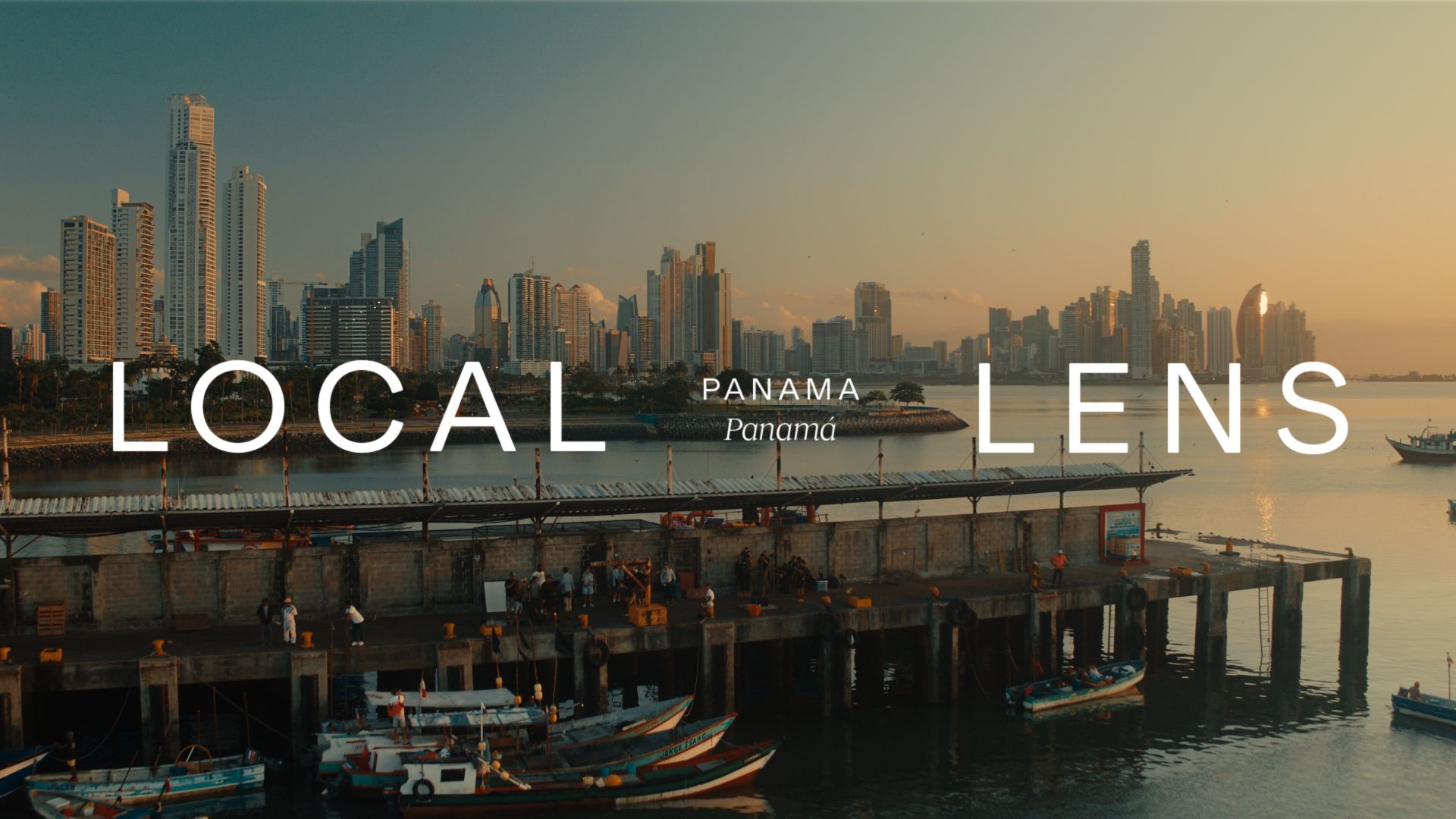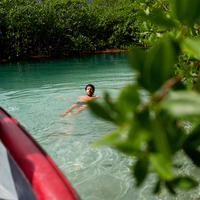A food lover’s guide to Panama
By Rachel Sullivan
Photos by Miriam Patience
March 2025
Follow chef José Olmedo Carles Rojas on a whirlwind culinary tour of this extraordinary country, sandwiched between the Pacific and the Caribbean
“Every time I come home to Panama, the first thing I do? Eat!” Coming from chef José Olmedo Carles Rojas, something of a culinary rock star in his home country, this is hardly surprising: Celebrating Panama’s cuisine is his life’s work. A peaceful, eco-conscious nation that lives up to its name—said to mean “an abundance of fish”—it’s home to hundreds of species, thanks to its unique location between the Pacific Ocean and Caribbean Sea, as well as its inland rivers and the huge, man-made Gatun Lake through which ships pass as they traverse the Panama Canal.

There’s no better person than José to take Expedia on a food-focused tour, from informal street-food fondas to the capital’s high-end creative culinary scene, and diverse regional tribal cooking. The chef-owner of Panama City restaurant Fonda Lo Que Hay and pioneer of an exploding modern Panamanian food movement, he’s regularly name-checked in “best of” lists. And helping us capture the adventure is his wife, filmmaker, Miami native and “honorary Panamanian” Chevy Tyler.
The couple met when she moved from the U.S. and visited his first restaurant, Donde José, in 2014. Already entranced by this “sliver of Central America between two oceans, with a unique fusion of cultures and history,” she was even more blown away by José’s food. “I saw him in his element: focused, passionate, and so, so proud,” she says. “And the food… I still think about it. That menu blew my mind.”

It was the start of a love affair, both with José and this incredible country—beginning with the fast-paced capital, with its ocean views and skyscrapers that stand beside monuments to the past. “If you have one day in the capital? It should involve a little bit of drinking, a little bit of eating for sure,” says José. “Start with Chinese dim-sum breakfast at Lung Fung; it’s packed at 7 a.m. with some people starting the day, some coming from a party.”
Next, take in the miracle of engineering that is the Panama Canal. “If you don’t have time for a full tour, go to an up-and-coming area called Clayton,” says José. Caffeinate at Mendó, buy a flaky pastry from Gamboa Baking Co. next door, then head to the Miraflores Visitor Center. Arrive early morning or late afternoon to watch tankers make this awe-inspiring journey (check timings here).

Panama travel guides
Later, stop off at Fonda Lo Que Hay to experience José’s inventive, conceptual take on classic Latin American dishes (try the Sexy Clams, oozing with garlic and coconut milk and topped with chili crunch cashews). Walk it off in the city’s historic Casco Antiguo neighborhood (also known as Casco Viejo, or San Felipe), before seeing the sun set across the Pacific at the Amador Causeway.
As well as being next to an ocean, Panama City is an urban enclave enveloped by jungle, so you don’t have to travel far to be immersed in unspoiled nature. “A lot of Panama’s biodiversity is pristine,” says José. “It feels like you’re in National Geographic.”
Like its eco-tourism superstar neighbor, Costa Rica, the country is rich in natural attractions: protected parks teeming with howler monkeys, jaguars, sloths and ocelots; tropical hikes to crashing waterfalls; reef-encircled islets, abundant in greenery and dotted with sun-soaked slivers of sand. You have Tierras Altas with its lush rainforest reserves, active volcanoes and mineral-rich hot springs, then classic surfer towns like Santa Catalina. It’s not surprising, then, that Panama is doubling down on its climate responsibilities—it’s one of very few carbon-neutral countries in the world. “That’s amazing, and it doesn’t get shouted about enough.”
José and Chevy’s Panama itinerary



















Panama also boasts something utterly unique: geography that allows you to crisscross the country so fast, you can surf the Pacific in the morning and drink beer by the Caribbean at sunset. “The fact that you can dive into both oceans by driving less than two hours is still wild to me,” says Chevy. And the coasts are rich in contrast, not least in the food. “On the Pacific side, it’s all clean flavors, fish, plantain, rice and beans. On the Caribbean coast, you find coconut, spices, seafood—hot sauce on every table,” explains José.
Those differences run deep. “In the Caribbean, it’s all green,” he adds. “The water, the forest, the seaweed. The people are so beautiful and alive, with so much to share: the Congo culture, its colorful dress and storytelling dances, and the Afro-Antillean influence in the architecture.” Find that Caribbean culture in the brightly colored beach shacks, Spanish colonial ruins and protected national park of Portobelo. Or take a plane ride from the capital to Bocas del Toro, an island paradise with wooden overwater bungalows and white crescent beaches that’s tipped by Forbes to become “the next coolest place on earth.”
On the Pacific coast, meanwhile, “the water feels more blue,” marvels José. “Nature changes more drastically. When you drive from Cambutal, the first beach is dark sand, then it’s crazy rocks, then the sand becomes green.”

“In my perfect day, I’d go to a little town called Cambutal. We did this on one of our first dates,” says Chevy. Horseback-riding trips are available from the town, where Panamanian cowboy culture is alive and well.

Lose yourself among the colorful streets of Panama City's old town, Casco Antiguo.

Chef José Olmedo Carles Rojas at his old town restaurant, Fonda Lo Que Hay.

The ultimate order? Cassava Tostada and Sexy Clams.

“Fondas are an essential part of life here," says José. "Simple spaces to share a pot of something delicious. No frills, no fuss.”

Also in the old town, La Calle de los Sombreros—“Hat Street”—is aptly named.

Thanks to its unique climate and proximity to two oceans, Panama has some of the best Geisha coffee in the world, a highly prized variety that balances acidity with sweetness.

“Even though I grew up here, I’m still amazed by the Panama Canal," says José. "Seeing all those huge boats lined up to go through, it’s incredible.”

The volcanic Isla Taboga, or the "Island of Flowers," is the perfect beach day trip from Panama City.

“In Panama you could be on a world-class wave and there are hardly any people in the ocean,” says José.

At the village of Parara Purú, in the the Chagres River National Park, members of the Emberá community prepare fruit platters for guests.

The Emberá also share their temporary tattoos, drawn with the ink of the jagua fruit, with visitors.

Pipa fria—coconut water—is the traditional way to stay refreshed in the tropical heat.

In Tierras Altas, in the Chiriquí Province, you can hike the highest peak in Panama: the Barú Volcano (11,410 feet above sea level).

“In my perfect day, I’d go to a little town called Cambutal. We did this on one of our first dates,” says Chevy. Horseback-riding trips are available from the town, where Panamanian cowboy culture is alive and well.

Lose yourself among the colorful streets of Panama City's old town, Casco Antiguo.

Chef José Olmedo Carles Rojas at his old town restaurant, Fonda Lo Que Hay.

The ultimate order? Cassava Tostada and Sexy Clams.

“Fondas are an essential part of life here," says José. "Simple spaces to share a pot of something delicious. No frills, no fuss.”

Also in the old town, La Calle de los Sombreros—“Hat Street”—is aptly named.

Thanks to its unique climate and proximity to two oceans, Panama has some of the best Geisha coffee in the world, a highly prized variety that balances acidity with sweetness.

“Even though I grew up here, I’m still amazed by the Panama Canal," says José. "Seeing all those huge boats lined up to go through, it’s incredible.”

The volcanic Isla Taboga, or the "Island of Flowers," is the perfect beach day trip from Panama City.

“In Panama you could be on a world-class wave and there are hardly any people in the ocean,” says José.

At the village of Parara Purú, in the the Chagres River National Park, members of the Emberá community prepare fruit platters for guests.

The Emberá also share their temporary tattoos, drawn with the ink of the jagua fruit, with visitors.

Pipa fria—coconut water—is the traditional way to stay refreshed in the tropical heat.

In Tierras Altas, in the Chiriquí Province, you can hike the highest peak in Panama: the Barú Volcano (11,410 feet above sea level).

“In my perfect day, I’d go to a little town called Cambutal. We did this on one of our first dates,” says Chevy. Horseback-riding trips are available from the town, where Panamanian cowboy culture is alive and well.










































Key to understanding Panama’s history and its food culture are its Indigenous tribes, some of which, like the Emberá community, live in villages travelers can visit. “In such a small place, there are so many different cultural beliefs, so many different histories,” says José. “The Aztecs and the Incas, their growth was based on disputes, fights, wars, conquering. But Panama was a safe haven, and that says a lot about our character: We’re cool here. We’ll be here chilling in our own little piece of paradise.”
It explains a lot about why this extraordinary country is so diverse, so untouched, and so ripe for making discoveries of your own, in places that feel as though no human has set foot there before. “There’s no manual in Panama,” says José. “Here, you make your own adventure.”

Plan the ultimate Panama itinerary
From the canal to the jungle to sea, here's everything you'll want to see
Panama’s characterful capital, framed by the Pacific Ocean and man-made Panama Canal, is famed for its historic, cobblestoned center, beachy islands just off its coast, and—of course—its flavor-packed food scene. Spend at least a couple of days exploring and eating your way around this diverse city.
More than 1,800 miles of coastline and 1,400 islands and cays make Panama the ultimate beach destination—and with contrasting Pacific and Caribbean coasts, there’s a spot to suit any mood. The Caribbean coast is known for its turquoise waters and palm trees; the Pacific for its wilder beauty. Which will you head to first?
With almost 13 million acres of some of the world’s most biodiverse rainforests, rich with jaguars, hummingbirds, and butterfly species, Panama is a nature lover’s dream. Hike mountainous peaks, float down glittering rivers, and see wondrous waterfalls. The forests are also home to many of Panama’s Indigenous communities, whom you can visit to learn about their beliefs and share a traditional meal.

Rachel Sullivan is Expedia Group’s Creative Director of Editorial. Before joining Expedia, she had a career in magazine publishing, writing for titles from Condé Nast Traveller to Brides, Red and The Sunday Times.
Panama hotel deals






